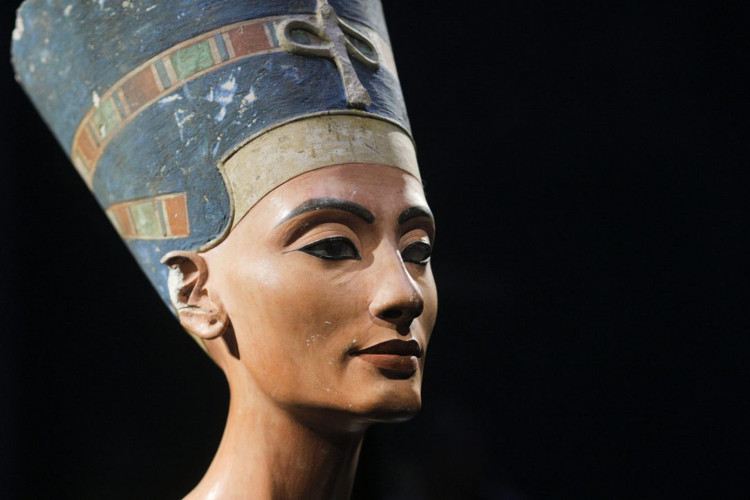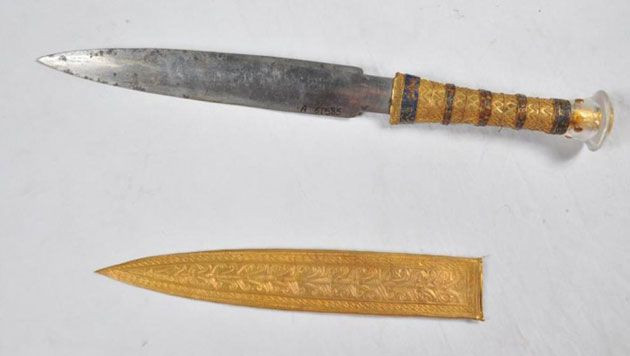The secrets of ancient Egypt were revealed in 2016
2016 is the year marking many interesting discoveries for ancient Egyptian civilization, from the mysterious tattoo on mummy skin to the pyramid protection machine.
Resting place of Queen Nefertiti
In 2016, many studies were conducted inside the pharaon Tutankhamun tomb since archaeologists thought the tomb contained some secret rooms. Researchers hope to find Queen Nefertiti's remains in one of these rooms, according to the International Business Times.

Bust of queen Nefertiti.(Photo: Biography).
The theory was first published in a controversial study by Nicholas Reeves, an archaeologist at the University of Arizona, in 2015. Reeves said the tomb of pharaoh Tutankhamun of the 18th Egyptian dynasty contained two Secret passage, capable of leading into Nefertiti's final resting place.
Scientists conducted various infrared and radar analyzes inside the pharaoh Tutankhamun tomb. But research results cannot convince all archaeologists about the need to drill through walls to discover tomb secrets.
Neferneferuaten Nefertiti (1370-1340 BC) is a famous beautiful queen married to pharaoh Akhenaten. Her popularity is second only to Queen Cleopatra. Queen Nefertiti's tomb position is one of the biggest secrets of Egyptology.
Dao stewed from meteorite of King Tutankhamun
Pharaoh Tutankhamun, aka King Tut, attracted much attention from the scientific community this year when a dagger was found inside his grave.

The dagger buried with the pharaoh Tutankhamun contains metal that originates from meteorites.(Photo: Daniela Comelli).
The researchers used X-rays and fluorescence spectroscopy methods to understand the composition of the dagger. They found high levels of nickel on the dagger. The proportion of nickel and cobalt shows that the dagger originated from extraterrestrial meteorites. The results of the study are published in the journal Meteoritics & Planetary Science in late May.
Scholars have long speculated that ancient Egyptians used meteorite metal to create objects such as weapons. The analysis of daggers taken from the tomb of King Tut is a strong testimony to this observation. The reason may be that ancient Egyptians did not know how to iron iron from ore, instead they took metal iron from meteorites that fell to Earth.
Tattoo on mummy Egyptian women
A mummy of 3,000 years old women was found at Deir el-Medina, Egypt in 2014. Anne Austin, a researcher at the French Oriental Archeology Institute, discovered many sophisticated drawings with ink. on the mummy's neck. At first, Austin thought the symbols were painted on the skin, but then she realized they were actually tattoos.

Tattoos of Wadjet's eyes on mummy's neck.(Photo: Anne Austin).
In early 2016, Austin and his colleague Cedric Gobeil took X-rays and infrared images of mummy skin to collect complete data on the number of tattoos on a woman's body. The mummy has about 30 complex tattoos such as lotus, cow, baboon and Wadjet's eye. Symbolic tattoo for the devotion of the dead throughout life. The mummy is most likely an important religious figure.
"This mummy is very interesting because it originated from the New Dynasty (New Kingdom) period in ancient Egypt. Many people said that during this time, women lost influence in the field of religion. They are rarely honored as priestesses of goddesses like Hathor, the god who embodies joy, love and maternal love, and the tattoos on this mummy make the scientists change their minds. on, " Austin said.
Lady Sattjeni's coffin
Although archaeologists have not yet discovered Queen Nefertiti's resting place, they found the remains of another powerful woman called Lady Sattjeni , who lived around 1800 BC. The coffin of Lady Sattjeni made of cedar wood was discovered at a place on the banks of the Nile.

Lady Sattjeni was found in a coffin made of cedar wood.(Photo: Egyptian Antiquities).
Lady Sattjeni is a fairly famous person in the 12th dynasty of the Dynasty between (Middle Kingdom) of Egypt. She is the leader of the Elephantine region in the pharaoh dynasty Amenemhat III.
Heqaib III and Ameny-Seneb, her two sons, later became two key leaders in the Elephantine region. This is a strategic position between the Egyptian and Nubian borders. The role of the Sattjeni family is very important for the expansion of Egypt.
The machine defends inside the pyramid
To prevent the pharaoh's tomb from being looted, the ancient Egyptians built machines inside the pyramid to protect the king's tomb. Mark Lenher, an Egyptian learner, uses digital technology to recreate the defense system inside the Great Pyramid of Giza, Egypt.

Three granite blocks fall down a path to block the way into the king's room inside the pyramid.(Photo: Science Channel).
The Great Pyramid of Giza was built about 4,500 years ago and was completed in 2560 BC under the fourth pharaoh Khufu dynasty. Some scholars believe that the king's room inside the Great Pyramid of Giza contains the pharaoh Khufu's corpse.
Surrounding the king's room are stone blocks about 80m thick. Realizing that the passage was not protected safely, the builder carved the grooves just outside the entrance to the room, hidden beneath the pyramid wall. Then, they put huge granite slabs into the trenches, which will stop anyone's path to go deep into the pyramid.
- Egypt revealed a stone gate leading to the king's treasure
- Why do ancient Egyptians only sex in the summer?
- The papyrus suddenly revealed the love of ancient Egypt
- Homosexuality in ancient Egypt
- Learn the disasters that destroyed ancient Egypt
- 6 things we do not know about the people of ancient Egypt
- The tomb of the Queen of Egypt may reveal many secrets
- 3 everyday items you won't believe are from ancient Egypt
- Mysterious mysteries of ancient Egypt
- Discovered an ancient tomb over 3,500 years old in Egypt
- New timeline for the beginning of ancient Egypt
- 56 jars in the tomb of the prime minister of Egypt contain great secrets
 Discovered an ancient centipede fossil 99 million years old
Discovered an ancient centipede fossil 99 million years old Discovered bat-like dinosaurs in China
Discovered bat-like dinosaurs in China Discovered a 200-year-old bronze cannon of the coast
Discovered a 200-year-old bronze cannon of the coast Discover 305 million-year-old spider fossils
Discover 305 million-year-old spider fossils